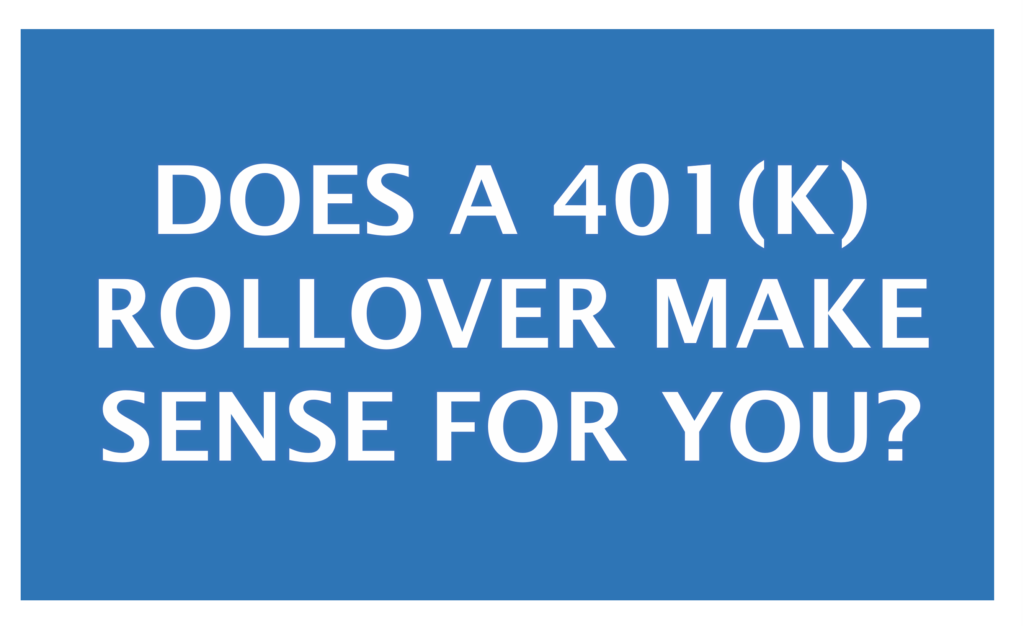As of June 30, 2022, financial advisors must adhere to Department of Labor (DOL) Rule PTE 2020-02 when advising clients 401(k) rollovers to an IRA account.
Here is a great summary of the change.
And here is a quote of the most relevant part.
Specifically, advisors who would receive increased compensation as a result of recommending a rollover must qualify for an exemption from the DOL’s prohibited transaction rules by complying with the new standards outlined by DOL.
This means that pretty much every financial advisor not charging a flat fee must adhere to the new rules.

So what exactly is changing?
Going forward, if an advisor recommends a 401(k) rollover, and that advisor has a financial incentive to do so, then the advisor must document the reasons why the rollover makes sense for the client. This documentation/analysis must cover the following areas:
- rollover alternatives (including leaving the money where it is)
- the fees of the 401(k) plan compared to the fees of the advisor-managed IRA
- an analysis of whether the employer pays any share of the 401(k) plan’s admin expenses
- any changes in service or investments between the 401(k) plan and the advisor-managed IRA
At a minimum, the advisor must obtain the 401(k) plan’s Summary Plan Description (SPD) as well as any available information about fees and investment options in the plan. If the advisor doesn’t receive this information, then there is no way they can complete their assessment.
The advisor must provide the client with a copy of their analysis and, ideally, explain to the client why a rollover makes sense.
Why is this happening?
Every advisor charging the typical 1%-of-assets fee has a conflict of interest when it comes to 401(k) rollovers for clients. It’s a not-so-well-kept secret in the industry that many financial advisors push clients to execute 401(k) rollovers whenever possible. Sometimes even when it doesn’t make sense for the client. The reason for this comes down to money.
Many clients accumulate the vast majority of their retirement savings within their employer sponsored retirement plan. And if an advisor can’t manage those assets, then they don’t get paid as much. But if the advisor can convince the client to transfer the assets to an IRA, then problem solved! The advisor is now earning a much higher fee.
Under most circumstances, moving from a 401(k) plan to an IRA managed by a 1%-of-assets advisor does not make sense for the client. Yes, it’s true that IRAs offer more flexibility around investments compared to a 401(k) plan. But does that additional flexibility justify an additional 1% advisory fee? Not likely.
And don’t forget that rollovers are a one-way street. For many 401(k) plans, once the assets leave, they can’t come back.
At the end of the day, the DOL is trying to bring more attention to the rollover process. Hopefully, clients will be able to make more informed choices when it comes to this decision.
A real life example
Let’s look at a example that many folks have encountered. A doctor named Randall is looking to retire in a couple months. He has saved up the following amounts for his retirement:
- $1,000,000 in a taxable brokerage account
- $3,000,000 in his employer sponsored retirement plan
Randall has worked with a typical 1%-of-assets financial advisor for many years. He enjoys working with his advisor and plans to continue to do so. However, Randall’s advisor only manages (and gets paid on) the value of the taxable brokerage account. So the advisor currently earns $10,000 per year.
It’s important to note that up to this point, Randall’s advisor likely has never mentioned the word “rollover” once. The reason for this is simple… most employer retirement plans (including Randall’s) don’t allow active employees to remove assets. So a rollover isn’t possible until Randall retires, dies, quits, or gets fired.
However, now that Randall is retiring, the race is on for the advisor to secure the rollover. Randall’s advisor can quadruple his earnings (from $10,000 to $40,000 per year) overnight. And Randall’s advisor really doesn’t need to do any additional work. The advisor helps Randall transfer the assets and perhaps makes a few trades in the new IRA account.
From Randall’s perspective, the benefits of the rollover are less obvious. Yes, the advisor will provide advice around the assets, but the advisor likely already did that. In fact, most fiduciary advisors would be crazy to tell clients, “Sorry, I can’t give you advice on your 401(k) because I don’t get paid on those assets.”
Technology can bail out advisors
For many advisors, the solution to this whole problem has been to find a way to simply charge fees on the 401(k) assets directly and avoid the rollover recommendation.
Some advisors do this by billing on something called “assets under advisement” (AUA) instead of “assets under management” (AUM). With AUA billing, advisors extend the fee’s reach to non-managed accounts such as 401(k) plans, 529 accounts, or health savings accounts (HSAs).
Other advisors are turning to technology. Tech companies such as Pontera offer a way for financial advisors to access a client’s 401(k) plan and manage the assets directly. The technology allows advisors to communicate with almost any type of account. So the advisor can transmit trading instructions and receive updated asset values on a daily basis and an easier path towards billing on the assets.
I’m only providing education
Other advisors are taking the approach of merely providing “education” about rollovers. These advisors will avoid providing a rollover recommendation to clients, and thus will avoid having to conform to the new DOL requirements.
This sounds good in theory, but I’m skeptical that most advisors will be able to truly stick with this plan. My guess is these advisors will ask clients to sign a document saying that the advisor only provided education, but will still verbally encourage the client to move forward with the rollover.
Rollovers are a BIG deal
Rollovers are a BIG deal for many financial advisory firms as many of them are heavily dependent on rollovers for future growth. Most clients of financial advisors are in their 60s, 70s, and 80s. And these are the ages when people have the most money to manage. And most of that money is held in employer-based retirement plans.
Retirees are also spending down their assets as they are no longer working. These same asset-based financial advisory firm need to find assets to replace what’s going out. There are really 4 main ways to do this:
- Market appreciation
- Gather assets from new clients
- Gather assets from existing clients
- Buy another advisory firm
By far the best method is #3. It requires less work from the advisor when compared to #2 and #4. And financial advisors can’t really control #1. As I mentioned in this post, most advisors are incentivized to gather assets as not improve returns.
What’s the largest source of assets available from existing clients? The assets in retirement plans! So if you work for a financial advisor who charges the typical 1%-of-assets, and you have a 401(k) plan, don’t be surprised when they come asking to manage it!
From my point of view, it’s far better to work with a flat fee advisor. A flat fee removes the financial incentive for the advisor to recommend the rollover and brings to focus back to what is best for the client. There are a whole host of variables that can influence a rollover decision, and if your financial advisor’s conflict of interest is clouding the process, then it’s possible you won’t be able to make the best possible decision.

